Farming Potatoes In South Africa: What You Need To Know
“My idea of heaven is a great big baked potato and someone to share it with.”
- Oprah Winfrey

Chapter 1
Introduction: Farming Potatoes in South Africa
In South Africa, maize meal and bread are the most commonly consumed sources of carbohydrates. However, South Africans have eaten twice as many potatoes over the past decade compared to the decade before it, buoyed by a growing middle class.
This increase in consumption has occurred despite the rising input costs, unstable weather conditions and, more recently, the overall uncertainty brought about by COVID-19.
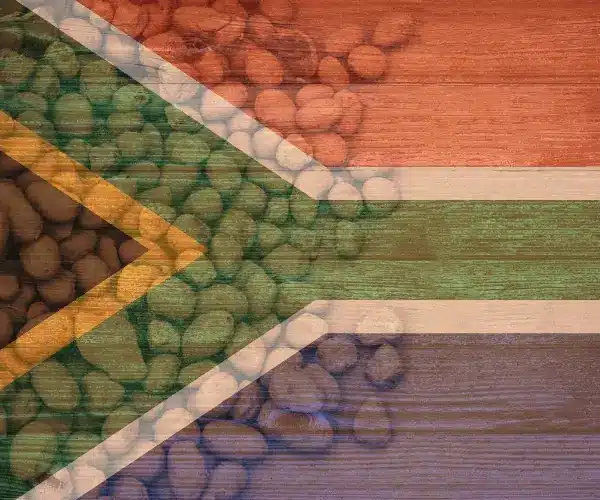
The role of potatoes in the food system
“What I say is that, if a man really likes potatoes, he must be a pretty decent sort of fellow.”
- A. A. Milne
Fresh potatoes have remained one of the world’s favourite foods for thousands of years. In his book Notes of a Potato Watcher, sociologist James Lang wrote: “No crop produced more food per acre, demanded less cultivation and stored as easily as the potato.” Potatoes were prized by villagers since they provided an unmatched nutritional yield per hectare.
Potatoes contain almost all important vitamins and nutrients, except vitamins A and D. This makes them unrivalled by any other single crop. Keeping the skin on and adding some dairy (which contains the missing vitamins) creates a healthy human diet staple.
Here's why potatoes are such a powerhouse
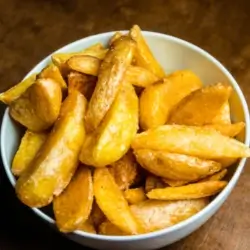
Multifaceted
Can be adapted to many different cooking purposes and occasions
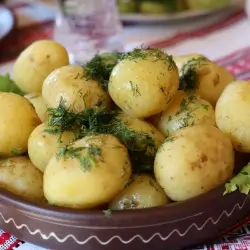
Undemanding
Easy to prepare and turn into something delicious

Nutrient-dense
Especially when baked, boiled or grilled
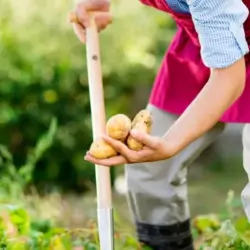
High in carbohydrates
Fuelling the body
Fast facts about South Africa’s potato industry*
570
South African potato farmers
16
Production regions
12
Months of production
2.6
million tonnes
Total potato crop in 2020
263
million
10kg pockets of potatoes produced in 2020
50 000 - 60 000
Permanent and seasonal labourers
R7.5-billion
Primary level worth
R26-billion
Secondary level worth
51 000 ha
Planted per year
45%
Of all vegetable crops produced in SA are potatoes
Chapter 2
All About Seed Potatoes
The South African potato industry competes with the best in the world in terms of both yield and quality. At an average of 47 tonnes per hectare, South Africa’s production capacity is comparable to the USA, Germany and the Netherlands.
Under the country’s Seed Potato Certification Scheme—one of the best in the world— the quality of South African seed potatoes is attracting international attention.
Former CEO of Potatoes South Africa, Dr André Jooste, once said: “Everything starts with seed; you could say it’s a seed value chain. Within that chain, we have exceptional cooperation and dialogue between Government and the industry, comprising not only seed potato producers but also table potato producers and processing potato producers. It’s all about the integrity in carrying out the stipulations, the level of our laboratories, the rigorous training of seed certification officers employed by the Seed Potato Certification Service.”
He continued: “South African potato producers obtain the best possible seed for production and, as a result, our potatoes are of a very high quality. When you ask potato producers in other African countries what the single most limiting factor is to higher yields, the answer is always: inferior seed.”
What are seed potatoes?
Seed potatoes are used to “seed” the soil and grow new potatoes. Rather than planting from seeds produced by the flowers of the plant, potatoes are generally grown by planting portions of the root structure—seed potatoes. Just like any other seed, seed potatoes are replanted and to produce more potatoes.
Seed potatoes aren’t actually seeds; they are tubers that can be used to grow new potatoes that will be genetically identical to the parent potato. A seed potato is a potato that has grown a young sprouting stem called an “eye”.
Since potatoes are quite susceptible to soil-borne rots, viruses and pests, seed potato growers ensure that their crop has been subjected to agricultural testing to ensure they are disease-free. Seed potatoes are produced from new plants every few years to ensure vigour.
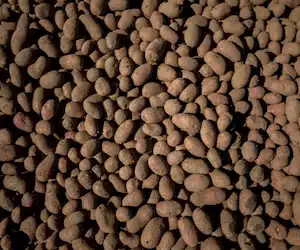
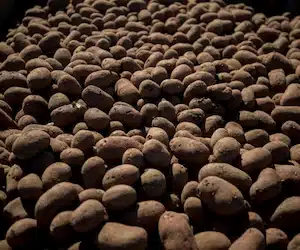
Where to buy seed potatoes in South Africa?
Make sure that your seed potatoes are sourced from certified dealers. The seeds themselves should be well-graded and uniform in size.
At RegenZ, we develop and commercialise seed potatoes, supplying bulk seed potato orders to large growers. We also administer the breeding programmes for new and registered potato varieties and manage the entire contract seed potato growing process. Two of our very experienced seed potato grower partners are PiDelta in Greytown and Ivanhoe Farming Company based in the Midlands, KZN. Seed potatoes can be ordered through us.
Chapter 3
Growing potatoes in South Africa
Potato growing in South Africa
The growth and development of the potato plant is divided into five stages:

Sprouting
Vegetative Growth
Tuber Inititation
Tuber Bulking
Maturity
Different aspects are important at different times in the growth cycle.
For example, at tuber initiation, any drought stress will reduce yield. In the tuber bulking stage, it’s vitally important to keep the leaves healthy and maintain adequate moisture levels.
What type of potatoes can I grow?
Choice of cultivar choice depends on disease resistance, climate, adaptability as well as the use of the crop. For example, will it be used for table, crisps, french fries?
The factors that affect your choice of which cultivar to use include:
- Yield
- Seed availability
- Disease resistance
- Maturity
- Market
Choosing and Growing the Perfect Potato
In this blog post, we’ll look at some of the major categories of potatoes in more detail.
When to plant seed potatoes in South Africa?
The best time to plant potatoes is dependent on the region and requirements.
- In frost-free areas, potatoes can be planted from August to early June the following year.
- In areas where frost is prevalent, planting is best contained from August to December into early January.
Spring
(August/September/October)
Slow development of tubers due to days growing longer and temperatures increasing.
How to plant seed potatoes
Propagation | Done by seed potatoes or tubers |
Planting Method | By had or mechanical planter 150mm deep Ridge to protect the plants once they reach 25 to 30 cm in height |
Spacing | 20 to 30 cm apart Rows 80 to 100 cm apart |
Fertilisation | There are good organic fertilisers that do very well with potatoes |
Irrigation | Moist (not wet) soil at planting Irrigate twice weekly Between 30 and 40 mm of irrigation per week (increased in the case of high temperatures and sandy soils) Start to reduce irrigation when the plants start dying back nearing harvest |
Harvesting | With a mechanical lifter or by hand Move tubers to a cool, dry area Wash and grade potatoes after harvesting according to market grading requirements Bag and label the potato pockets according to the size and cultivar |
How long do potatoes take to grow in South Africa?
Young shoots start to appear anywhere from one week to three weeks after planting. The total growth period ranges from about 110 to 150 days from planting. If you are harvesting new potatoes, they may be ready by day 60.

Conservative: 15 Tonnes
What potato yields can I expect?

Good: 40+ Tonnes

Average: 30 Tonnes
5 Tips for Growing Potatoes in South Africa
- Start with a soil test to understand how best to manage the land.
- Prepare your field well in advance – this includes improving soil health and composting.
- Space your furrows evenly, and fertilise them well.
- Make sure that seeds are adequately covered after planting.
- Scout for pests and diseases regularly.
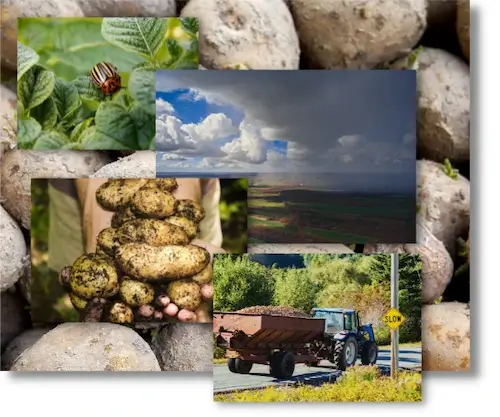
Chapter 4
Challenges of Potato Farming
Farming potatoes in South Africa can be profitable, but is by no means an easy endeavour. There are a number of factors limiting potato production and profitability in South Africa. These include:
- Management
- Climate
- Pests and diseases
- Harvesting
- Production costs
- Agricultural dumping
Management
There are numerous considerations to bear in mind when managing a potato farm in South Africa. Along with selecting a potato cultivar, you need to consider the season in which you are going to carry out your potato farming as well as your target market.
Importantly, the size of the crop should match the capabilities of the farm’s pest and weed control, crop nutrition, and irrigation capabilities. Under South Africa’s load-shedding schedule, potato farmers in South Africa also have to plan their crops around a future of interrupted power supply.
Fresh produce stocks need to be strategically managed to match the size of favourable markets. Avoiding an oversupply reduces the risk of leftover stock that goes for a lower price. Excess product could even become unmarketable and discarded, leaving the farmer with no income and a bill to foot for disposal costs.

Climate

Potato climatic requirements Cool growing conditions (average temperature 7°C -20°C) Little to no frost Good supply of moisture (800 – 1200mm/year) |
Potatoes are a cool-weather crop. The highest yields and best quality typically resulted in regions with mild temperatures, long days and ample rainfall. Most of the commercial potato varieties available in the world today were developed in the traditional potato-producing countries of the Northern Hemisphere.
In South Africa, the high temperatures, short day lengths, low humidity and erratic rainfall of many areas of the country meant that potato production was originally limited to specific areas where the climate suited the potato cultivars introduced from European countries; namely, the highlands of Mpumalanga and the Free State Provinces, with limited production in other scattered areas. As a result, potato production was very seasonal.
Production of potatoes in South Africa increased dramatically once the first locally developed varieties were released. These varieties were adapted to shorter day conditions and more tolerant to the prevailing pests and diseases. South African farmers also adapted by implementing different planting dates and seasons according to the climate of their region.
Now, potatoes are available year-round in South Africa in multiple provinces.
Pests & Diseases
Potatoes are sensitive to a range of pests and diseases, requiring intensive pest control.
Diseases affecting potatoes include:
- Late blight
- Early blight
- Leaf roll virus
- Scab
- Mosaic virus
- Nematodes
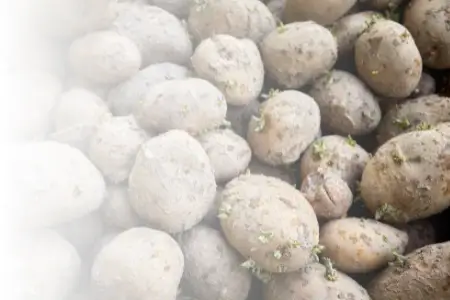
Harvesting
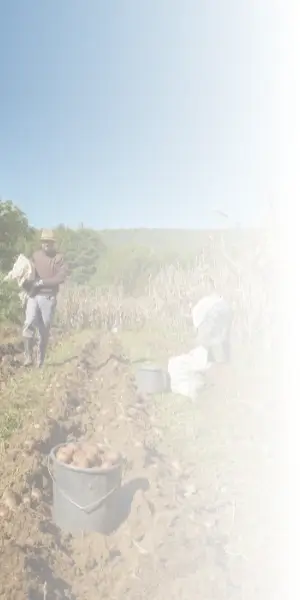
Potato harvesting in South Africa has a number of complexities involved in terms of climate, marketing, cultivar and more.
When to harvest potatoes in South Africa?
South Africa is one of only a few countries in the world where the climate and soils are sufficiently diverse to enable year-round potato production. Of course, each part of the country has its own optimal window for planting and harvesting potatoes.
Farmers can take advantage of supply-and-demand pricing dynamics by selling their harvests at times when potato supplies from other areas of South Africa are dwindling or not yet available.
GoldenGrow owner Graeme Jarvie uses precision farming to time potato production optimally. Situated in Greytown, KZN, an area with frequent winter frosts, and high clay, low pH gives GoldenGrow a relatively narrow window to plant, harvest and market their seed potatoes. Planting too early, for example, means that the plants will grow tall, which means they become more exposed to winter frost damage and require more sunlight.
In November and December, the Midlands mistbelt is often misty and drizzly, with suboptimal sunshine and heat units, which means that GoldenGrow needs to manage fungal leaf diseases during this time. But harvesting after February means market competition from potatoes harvested in parts of the Free State at that time.
If harvesting runs behind schedule, potatoes ready for harvesting will end up sitting unnecessarily long in the soil, increasing the risk of soil-borne pests and diseases. They could even start rotting. These subgrade potatoes then sell at lower prices.
As you can see, there is a lot to consider in timing the potato planning and harvesting process!
Potato Production Costs
Input costs for potatoes are higher than most crops. Therefore it is essential that growers use “best practice”; by testing the soil, planting virus-free material, controlling pests and diseases, applying sufficient fertiliser and irrigation (where available).
South African farmers receive zero government subsidies and are under immense cost pressures. Taking input costs, transport, marketing and production into account, potato product costs come to between R160,000 and R240,000 per hectare.
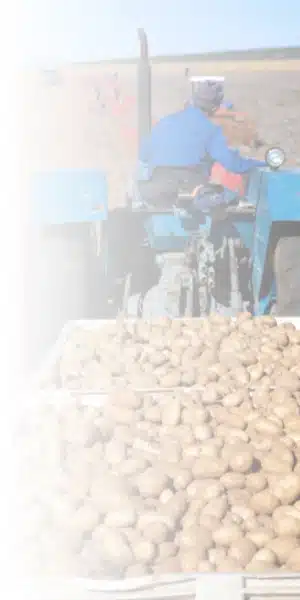
The Real Risks of Potato Dumping

Farming potatoes in South Africa became more challenging in 2021 and into the future due to the termination of anti-dumping duties in South Africa.
What is agricultural dumping?
Agricultural dumping refers to the practice of exporting commodities at prices well below the cost of production. |
Anti-dumping duties have been in place since 2016, protecting the local South Africa potato industry to a large extent. However, now that these duties have recently been terminated, we are anticipating an influx of cheap frozen and processed potato products from Europe. This puts the South African potato industry under severe threat since we have minimal power to defend our market.
South African producers don’t benefit from the financial support afforded to European Union (EU) farmers by their governments. As a result, they simply cannot compete with the below-cost products being dumped in our country. Less demand for local produce means a ripple effect on livelihoods, job losses and the economy.
The effects of the termination of anti-dumping duties
The lapse of the anti-dumping duties took place between January and May 2021. During that time, 11.8 million kilograms of frozen fries were imported to South Africa. This is 64.71% more than May 2020, and 199.19% more than May 2019.
Already, local farmers and producers have had to deal with the negative financial impact of the COVID-19 pandemic and other prevailing socio-economic and market conditions. Now, further threats may force some local growers and processors out of business.
Consumers have a role to play
To combat the effects of agricultural dumping, consumers need to actively support the local agricultural sector by reading the packaging and choosing South African potato products.
There are also ecological advantages to supporting South African spuds, including a smaller carbon footprint and the knowledge that locally-produced products are also typically linked to more environmentally friendly practices.
It’s also worth considering that agricultural dumping usually results from a high volume of surplus potato products that are not needed by the countries of origin. But these excesses often work in cycles—once the stocks have been depleted, the imports may dry up, causing periodic shortfalls and price spikes.
RegenZ’s Justin Platt says: “Dumping is bad news for the farmer and good news for the consumer—if the prices filter through, which they often do not! The middlemen (such as the importer or chain store) are usually are the main winners. Dumping destroys businesses, but the Government only really looks at the short term benefit to the consumer, especially just before an election. However, it is worth bearing in mind that our South African processing industry only uses about 20% of potato product grown, so the 80% used for table or fresh products is not affected.”
Chapter 5
Sustainable Potato Farming
Good agricultural management is the key to successful and sustainable potato farming in South Africa. Farmers need to understand the crop’s requirements and constraints to ensure cost-effective production of the highest quality under specific conditions. Adopting sustainable farming practices can help farmers achieve profitability and longevity.
Crane Friendly
Potato Trial Data
Coming Soon
Soil Health
The key to successful potato production is to maintain soil health. Potatoes can be grown in a variety of soils, but the best results come from solid with a good soil structure, lots of organic matter, good drainage and depth.
A soil pH of between 5.2 and 6.4 is most suitable for potato farming. Before planting, it’s advisable to conduct a soil test to see if any amends need to be made. A soil test identifies a number of soil health factors, including pH and moisture levels.
Soil health is also enhanced through sustainable farming practices.
Planting potatoes in the same field year after year causes a build-up of diseases and nematodes. It also diminishes soil health. That’s why it’s important to incorporate cover crops and crop rotation.
Example Potato Crop Rotation
- Year 1: Potatoes
- Year 2: Land rested
- Year 3: Onions or butternut
- Year 4: Sorghum used a cover crop, cut periodically to create a mulch layer and retain soil moisture
- Year 5: Back to potatoes, and the cycle starts again
The benefits of crop rotation, cover crops and mulching:
- Increases the number and diversity of organisms in the soil
- Potato farmers apply less or no fertiliser as the soil has leftover nutrients from the previous crop
- increases the level of carbon in the soil and aids in the growth of microorganisms
- Protects the soil from extreme weather
- Prevents weeds from taking over
- Spreads financial risk
- Helps break pest and disease cycles
- Promotes soil health
Cover Crops & Crop Rotation
Minimum Till
Reducing tillage creates a habitat that favours micro-organisms and helps to keep the soil healthy. A disc can be used to cut cover crops on the land, which can be ripped once the organic material is completely broken down.
In sustainable farming, compost is used in place of synthetic fertilisers. Best of all, compost can be produced in-house by combining cattle manure, wood chips, grass and any other off-cuts or excess plant material.
Composting
Precision
Farming
Instead of adopting a ‘spray and pray’ method, precision farmers only apply inputs based on actual measurement of needs. For example, at potato plant emergence, farmers apply a first top dressing of fertiliser based on leaf analysis, since nutrients vary year to year. The leaf analysis is then carried out regularly to determine the need for further fertilisation.
We also know that pests and diseases always attack the weaker plants first. So, rather than spraying correctively, precision potato farmers pray preventatively, avoiding heavy, red label poisons wherever possible.
Especially in areas with low rainfall, it’s important to manage water sources carefully by capturing as much of it as possible. Converting centre pivots into draglines results in less water evaporation and cuts water and electricity costs.
Water Management
The benefits of sustainable potato farming in South Africa
- Improved soil health
- A higher quality yield
- Better environmental outcomes
- Reduced reliance on toxic chemicals
- Reduced input costs
- More pest and disease resistance
- Potatoes with a longer shelf life
- Greater long-term profitability
Conclusion
When it comes to farming potatoes in South Africa, there are significant differences across the country in terms of climate, agro-ecological conditions, resource availability, and historical production. However, many potato farms in South Africa share the same challenges, such as dealing with agricultural dumping, reducing the use of pesticides, a lack of water availability for agriculture and an increased demand for improved tuber quality.
There are also common solutions:
- Choosing high-quality seed potatoes
- Adopting sustainable farming methods
- Prioritising soil health
By making concerted efforts in accordance with these principles, potato farms in South Africa have the opportunity to improve product quality, profitability and overall sustainability.